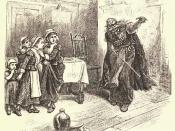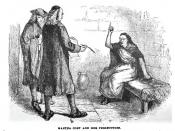Throughout the history of this country, Americans have shown that they are far from immune to the distorting and chaotic effects of emotion on their decision-making; and in a nation where the will of the people can determine the fate of laws, trials, and politicians, the publicÃÂs mental state can have a drastic and sometimes regrettable sway on the course of history. For example, whether one agrees with the Iraq War or not, it cannot be denied that much of the popular support drummed up at its outset was due to the intense public emotion in the aftermath of 9/11 ÃÂ the war has since claimed 4,200 American lives. During the Cold War, the rise of McCarthyism and anti-Communist paranoia led to the accusation and investigation of thousands of law-abiding citizens ÃÂ often leading to the demise of their careers and sometimes even imprisonment. Arthur Miller, the author of The Crucible, was himself subject to accusation and aggressive questioning about his supposed Communist activities, thus giving him a frightening glimpse into how those accused of witchcraft must have felt some 260 years prior in Salem, Massachusetts.
This undoubtedly influenced the themes he wove into his play, as an analysis of its plot and dialogue reveals that nearly all of the tragic events described in it were brought about by the power of fear and hysteria.
The mass panic in The Crucible had its roots, as irrational fears often do, in something true or legitimately worrisome. In this case, it was the mysterious illness of Rev. ParrisÃÂs daughter, Betty. She had fainted the night she was discovered by her father with a group of other girls in the forest, and had been in a seemingly coma-like state ever since; Rev. Parris was understandably scared, and eagerly sought a cure for his daughterÃÂs condition. Initially he went to the local doctor for help, but medical knowledge was still primitive at the time, and no diagnosis could be made. This lack of reasonable explanation was a source for panic, and thus opened the door wide open for another, more superstitious theory about the source of his daughterÃÂs ailment - witchcraft.
Witchcraft was exactly the topic that Rev. Parris had hoped to avoid. He was poorly respected as a minister, and was afraid that his already-endangered position within the community might suffer more still with the taint of the devil upon his home. Hoping to get a head-start on the rumors that were sure to spread, Parris angrily questioned his niece Abigail about what had gone on the night she went with the other girls into the forest. If she revealed that his suspicions were true, heÃÂd be in a very tight spot, as he explained to her in the opening scene:ÃÂParris: Now look you, child, your punishment will come in its time. But if you trafficked with spirits in the forest I must know it now, for surely my enemies will, and they will ruin me with itÃÂ (Miller 10).
Abigail had a reputation of her own to worry about, however, and so chose to lie about what happened and claim that they were ÃÂonly dancingÃÂ (when they had actually been casting love spells with Tituba, ParrisÃÂ slave). Abigail gathered the other girls together and threatened violence upon them should they differ from her version of the story. Terrified of Abigail, as well as the well-known legal consequences for any sort of occultist activities, the girls didnÃÂt hesitate to lie along with her.
All of their stories would quickly change, however, after the intellectual Rev. John Hale was summoned to examine Betty. Unable to rouse a response from her, Hale turned to Abigail, questioning her intensely about the nature of their dancing in the forest. She continued along with her lie at first, but ParrisÃÂ eyewitness account quickly ate away at the details of her story, and the finger of accusation drew dangerously closer to her with every intimidating question. Daunted by the consequences that might befall her should her growing deception collapse, Abigail quickly devised an escape:ÃÂAbigail: I didnÃÂt see no Devil! (Shaking Betty) Betty, wake up. Betty! Betty!Hale: You cannot evade me, Abigail. Did your cousin drink any of the brew in that kettle?[ÃÂ ](Mrs. Putnam enters with Tituba, and instantly Abigail points at Tituba.)Abigail: She made me do it! She made Betty do it! [ÃÂ ] She makes me drink blood!ÃÂ (Miller 45).
AbigailÃÂs sudden accusation was sloppy, and would have seemed obviously suspicious to any reasonable observerÃÂ but the panic surrounding Betty and the possibility of witchcraft had already taken hold, and so Rev. Hale and the others were eager to accept her new story ÃÂ it validated their paranoia.
Tituba was initially shocked at her accusation, vehemently denying any wrongdoing, but Rev. Hale and Parris put her through a terrifying interrogation laced with intimidation and death threats; the fear of her white masters quickly superseded her meek desires for dignity and exoneration, and so she gave in to their pressures and confessed, despite her actual innocence.
What began as a mere examination of Betty had now turned into a hysterical religious ritual, with Tituba pleading for GodÃÂs forgiveness and crying out the names of other so-called witches ÃÂ anything to please her accusers and escape their wrath. The already-fervent Rev. Hale and Parris welcomed TitubaÃÂs appeasement excitedly - Abigail saw in this a chance to both escape punishment, and to manipulate their emotions to her advantage. She, too, began to loudly praise God and claim to have seen other women with the Devil ÃÂ Betty quickly joined her. Their proclamations set off a powder-keg of panic and suspicion throughout the rest of Salem.
Before long, all of Salem was in a frenzy, with neighbors accusing neighbors, children accusing the elderly, everyone falling under the spell of fear and hopping on the witch-hunt bandwagon. Before long, thirty-nine people had been jailed after allegations of witchcraft, typically on the basis of the allegations alone as well as their refusal to propagate the lies by making a false confession. The majority of the townsfolk herded together against their perceived ÃÂgreat enemyÃÂ; and anyone who voiced even the slightest disagreement risked being ostracized and persecuted. Martha Corey, for instance, was outspoken in her disapproval of the proceedings; shortly afterwards, she found herself charged with cursing a neighborÃÂs pigs, and was later executed. No-one was out-of-reach of the court, not even Rebecca Nurse, a sagely and compassionate old grandmotherÃÂ who was accused of killing infants.
Spearheading the merciless campaign against perceived evil was Judge Danforth, a stern and unsympathetic man who saw the frightful specter of witchcraft as an extraordinary crisis, an evil taint that he was dead-set on purging out of Massachusetts. He brought a fearsome degree of efficiency and righteousness to the proceedings, and saw all things in black-and-white, as he explained in this quote from Act 3:ÃÂDanforth: [ÃÂ ] you must understand, sir, that a person is either with this court or he must be counted against it, there be no road between. This is a sharp time, now, a precise time ÃÂ we live no longer in the dusky afternoon when evil mixed itself with good and befuddled the world. Now, by GodÃÂs grace, the shining sun is up, and them that fear not light will surely praise itÃÂ (Miller 99).
His ÃÂus vs. them,ÃÂ attitude reflected an instinctual human response to danger ÃÂ a defense mechanism. Categorizing things into either good or evil, with no middle ground, was much easier than having to deal with pesky gray areas that, in his mind, impeded the course of justice. Unfortunately, it also paved the way for many innocent lives to be lost.
At the center of all the trials were Abigail and the girls, who had become experts at manipulating the emotions of the courtroom with their theatrics. At the start of the play, they were terrified that their dabblings with the occult might be discovered and punished by their pious elders; but soon they discovered that they could paint themselves as victims rather than troublemakers, and use the paranoia of the town for their own protection. This was showcased most dramatically when John Proctor and Mary Warren attempted to expose them all as frauds ÃÂ and they responded with a sensational group performance that led the astonished courtroom to believe that they were all under MaryÃÂs spell. They may have just been doing it out of selfish desires for attention ÃÂ but the games they played with fear led to very real repercussions for dozens of decent townspeople who did nothing to deserve them.
Arthur MillerÃÂs The Crucible is a powerful and tragic example of how fear and panic can tear a community apart. The suspicion permeating Salem supplanted all logic and drove people to believe that their neighbors, who they had once considered friendly and upstanding citizens, to be guilty of unspeakable crimes. Reason and common sense were pushed to the side in favor of religious fervor and survival instincts, with deadly results. The lesson to be learned is that the effect that emotion can have on the mind, and the terrible consequences it can lead to for society as a whole, are not to be taken lightly.
BIBLIOGRAPHY:Miller, Arthur. The Crucible. Viking Press, 1953.





